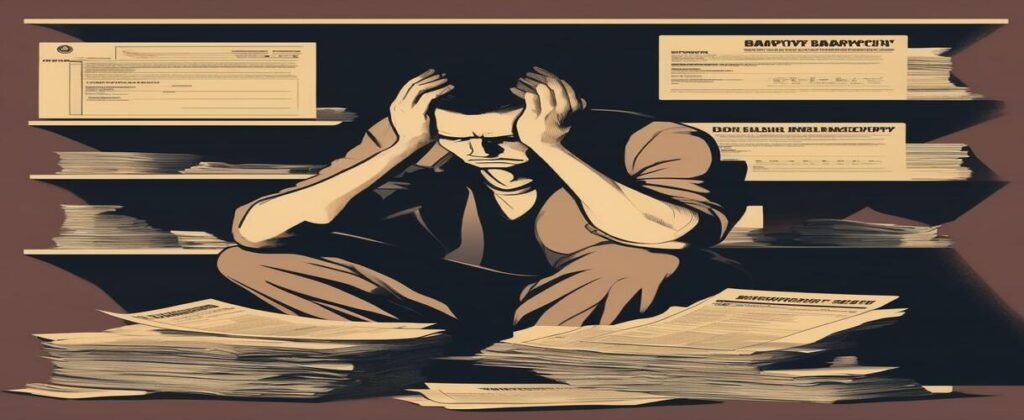
UNDERSTANDING BANKRUPTCY – A COMPREHENSIVE GUIDE
# Understanding Bankruptcy: A Comprehensive Guide
## Introduction
Bankruptcy is a legal process designed to provide relief for individuals and businesses struggling with overwhelming debt. It offers a way to either discharge debts completely or restructure them under the protection of federal law. This comprehensive guide will explain what bankruptcy is, the different types of bankruptcy, the filing process, its implications, and alternatives to consider before filing.
## What is Bankruptcy?
Bankruptcy is a legal status that can be initiated by individuals or businesses when they can no longer meet their financial obligations. It is governed by federal law in the United States and allows debtors to either eliminate their debts or create a repayment plan to manage them more effectively.
The bankruptcy process typically provides a fresh start for those facing insurmountable debt, but it also comes with implications that can affect credit ratings and financial futures.
TYPES OF BANKRUPTCY

There are several types of bankruptcy, with the most common being Chapter 7 and Chapter 13 for individuals:
### 1. **Chapter 7 Bankruptcy**
– **Liquidation Bankruptcy**: Also known as “liquidation bankruptcy,” Chapter 7 allows individuals to discharge most unsecured debts, such as credit card bills and medical debts.
– **Asset Liquidation**: In exchange for discharging debts, individuals may lose certain non-exempt assets, which are sold to pay creditors. However, many essential assets, such as a primary residence or car (up to a certain value), may be exempt.
– **Eligibility**: To qualify for Chapter 7, individuals must pass a means test, which assesses their income against the median income in their state. If their income is below the median or they can prove financial hardship, they can proceed with Chapter 7.
### 2. **Chapter 13 Bankruptcy**
– **Reorganization Bankruptcy**: Chapter 13 allows individuals with a regular income to propose a repayment plan to pay back a portion of their debts over three to five years.
– **Protection of Assets**: Unlike Chapter 7, Chapter 13 doesn’t require individuals to liquidate their assets, meaning they can keep their property while working to pay off their debts.
– **Eligibility**: Individuals must have a regular income and total unsecured debt within certain limits to qualify for Chapter 13.
### 3. **Chapter 11 Bankruptcy**
– **Business Reorganization**: Primarily for businesses, Chapter 11 allows companies to reorganize their debts while continuing operations. Creditors vote on the reorganization plan, which is then approved by the court.
– **Flexibility**: This type of bankruptcy is more complex and typically involves larger debts, allowing businesses to restructure while maintaining control over their operations.
### 4. **Chapter 12 Bankruptcy**
– **Family Farmers and Fishermen**: Chapter 12 is designed specifically for family farmers and fishermen with regular annual income. It provides a streamlined process for debt reorganization.
## The Bankruptcy Filing Process
1. **Credit Counseling**: Before filing for bankruptcy, individuals must complete a credit counseling session with an approved agency. A certificate of completion must be filed with the bankruptcy petition.
2. **Filing the Petition**: The debtor files a bankruptcy petition with the appropriate bankruptcy court, including detailed information about assets, liabilities, income, expenses, and recent financial transactions.
3. **Automatic Stay**: Upon filing, an automatic stay goes into effect, prohibiting creditors from initiating or continuing collection actions against the debtor.
4. **341 Meeting**: A meeting of creditors, known as the “341 meeting,” is scheduled. Here, the debtor must answer questions from creditors and the trustee overseeing the case.
5. **Bankruptcy Trustee**: A court-appointed trustee reviews the case, assesses assets, and manages the bankruptcy process, including distributing assets to creditors in Chapter 7 or overseeing the repayment plan in Chapter 13.
6. **Discharge of Debts**: If all requirements are met, a discharge is granted, releasing the debtor from liability for certain debts. Chapter 7 discharges usually occur within a few months, while Chapter 13 may take up to five years.
## Implications of Bankruptcy
### Effects on Credit
– **Credit Score Impact**: Bankruptcy severely affects credit scores, typically dropping by 100 points or more. A Chapter 7 bankruptcy remains on the credit report for ten years, while Chapter 13 stays for seven years.
– **Difficulty obtaining credit**: After bankruptcy, securing new loans or credit cards may be challenging, and if approved, higher interest rates may apply.
### Emotional and Social Impacts
– **Stigma of Bankruptcy**: There can be societal stigma associated with declaring bankruptcy, which may affect personal relationships and self-esteem.
– **Stress Relief**: Conversely, many individuals find relief from the stress of overwhelming debt, as bankruptcy can provide a fresh start.
## Alternatives to Bankruptcy
Before pursuing bankruptcy, individuals should consider alternative options, such as:
– **Debt Consolidation**: Merging multiple debts into a single loan with a potentially lower interest rate to simplify payments
SOCIAL IMPACTS OF BANKRUPTCY

Bankruptcy can have significant social impacts on individuals, families, and communities. Here are some key effects:
1. **Emotional and Psychological Effects**: Individuals who go through bankruptcy often experience feelings of shame, anxiety, and depression. The stigma associated with financial failure can lead to social isolation.
2. **Family Stress**: Financial strain can lead to increased tensions within families, potentially resulting in conflicts or breakdowns in relationships. Often, families may need to make significant lifestyle changes, leading to stress and anxiety.
3. **Loss of Social Status**: Declaring bankruptcy can affect an individual’s social standing, leading to feelings of inadequacy and a shift in how they are perceived by peers and society.
4. **Impact on Employment**: Bankruptcy can affect job prospects, especially in sectors where financial stability is paramount. Employers may view a bankruptcy filing as a risk when hiring for certain positions.
5. **Community Effects**: When businesses in a community declare bankruptcy, it may lead to job losses, reduced economic activity, and a decline in local services. This can create a ripple effect, impacting local economies and community cohesion.
6. **Long-Term Financial Implications**: Individuals who file for bankruptcy may face long-term challenges in rebuilding their credit and gaining access to loans or mortgages, which can hinder future financial stability.
7. **Social Services Strain**: Increased bankruptcy rates can put additional pressure on social services and welfare systems as more individuals and families may require assistance.
Understanding these impacts underscores the importance of financial education and robust support systems to help individuals navigate financial difficulties effectively.
BANKRUPTCY STATISTICS
Bankruptcy statistics in the USA highlight trends in individuals and businesses filing for bankruptcy protection. Here are some key points regarding bankruptcy in the United States:
1. **Types of Bankruptcy**:
– **Chapter 7**: Liquidation bankruptcy, where assets may be sold to pay creditors.
– **Chapter 13**: Reorganization bankruptcy for individuals with a regular income, allowing them to keep their property while repaying debts over time.
– **Chapter 11**: Primarily for businesses to reorganize and continue operating while repaying debts.
2. **Trends**:
– Bankruptcy filings tend to fluctuate based on economic conditions. Economic downturns typically see an increase in filings, while periods of growth may see a decline.
– Individuals constitute a significant portion of bankruptcy filings, with personal bankruptcy remaining relatively high due to factors such as medical debt, credit card debt, and unemployment.
3. **Statistics**:
– In recent years, the total number of bankruptcy filings has declined from the peak during the 2008 financial crisis. In 2020, there were about 544,463 bankruptcies filed, with a slight increase in 2021.
– The number of Chapter 7 filings generally exceeds Chapter 13 filings, although this can vary by year.
4. **Demographics**:
– Certain groups, such as individuals aged 45-54, tend to file for bankruptcy more frequently.
– Medical expenses are a leading cause of bankruptcy, affecting many households.
For the latest and most specific statistics, including yearly trends, you can refer to resources such as the American Bankruptcy Institute or the U.S. Courts website, which publish reports and insights on bankruptcy filings and trends in the USA.